We Made It! Everest Base Camp!
Everest Base Camp the Lazy Way Day 14
Sleeping in thermals, jeans, two fleeces, two pairs of socks and a snood, but neither hat nor gloves nor down outer layers, in a -30 rated sleeping bag under two quilts, we’re actually quite toasty at Gorak Shep, despite the cloud that’s come in.
It feels like a permanent change in the weather, as if winter has come. And, over breakfast, we argue about discuss what to do.
“We climb Kala Patthar in the morning?” says Nir, who, in my opinion, could do with more layers, but won’t say he does, and anyway all our clothes stink now, so I can’t offer him anything more than what I’ve already lent him unless he admits to positive desperation.
“No,” I say, pointing at the cloud cover. “We’re not going to see anything. I think we do Everest Base Camp in the morning, then if it clears, we do sunset at Kala Patthar.”
“So,” Nir says mournfully. “Two nights at Gorak Shep?”
“Yeah,” I say. “And if the weather doesn’t clear tonight, maybe we’ve got a chance at sunrise. If we don’t, we head straight down to Pheriche. It’s warmer, right?”
“Yes,” Nir says. “Minus five, maybe.” In the bracing atmosphere of a trekking lodge at Gorak Shep, such a temperature sounds quite indulgently tropical.
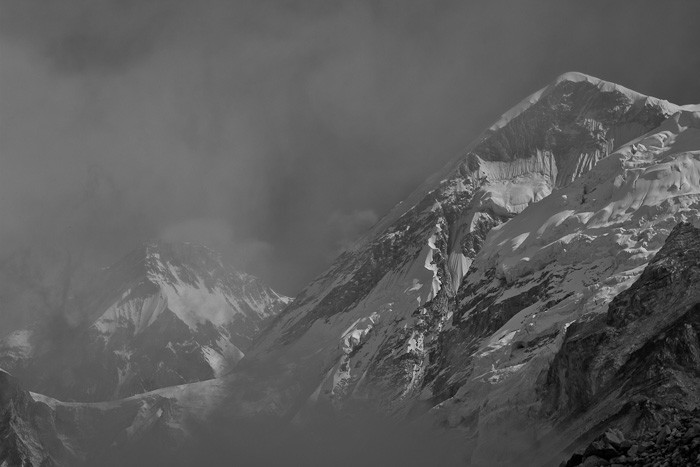
“Do we REALLY need to do Everest Base Camp?” asks Zac, who, like me, was so focussed on the Cho-La pass that he’s forgotten the theoretical point of this trip.
“YES,” I say, laying down a three line whip. “There’s nothing there, but it’s the bragging rights, and you’ll kick yourself if you’re an hour and half’s walk away from it, and don’t do it.”
“There ARE no bragging rights in Everest Base Camp when you’re twelve,” he says, not for the first time. “And there’s nothing even there! It’s just a moraine. There won’t be any tents there.”
“There will be when you’re eighteen,” I say. “AND, there’s a sign.”
Much to Zac’s distaste I’m quite tragically obsessed with signage, and the taking of photos in front of said sign (maybe I’m secretly Japanese). I also want to look up the Khumbu icefall.
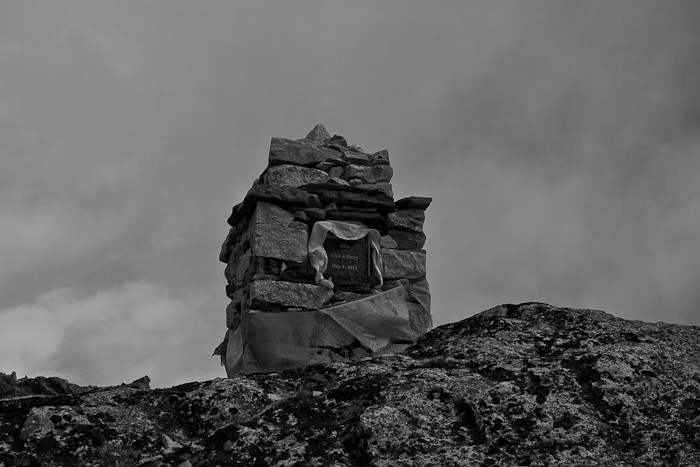
The path leads past an empty glacier lake through a vast landscape, with dazzling high mountain scenery: it would be hard, I feel, to get tired of this stark world of snow, rock and ice, the jagged slump of bluish icefalls descending Nuptse, the slabs of granite thrust up as plates collide, this almost unimaginably ancient place.
There are more memorials here, to soldiers from many armies who have died on the mountain, to expeditions from all over the world, to young men who have given their life up to conquer this ugly slab of a mountain. I wonder if their mothers ever visit them, like the mother we met in Egypt.
We head over the top of the valley and into moraine, where the path snakes over the top of great mounds of rubble and compacted ice, taking breaks before the dangerous place so we can cover it fast.
Nuptse, we agree, is a beautiful mountain to walk past.
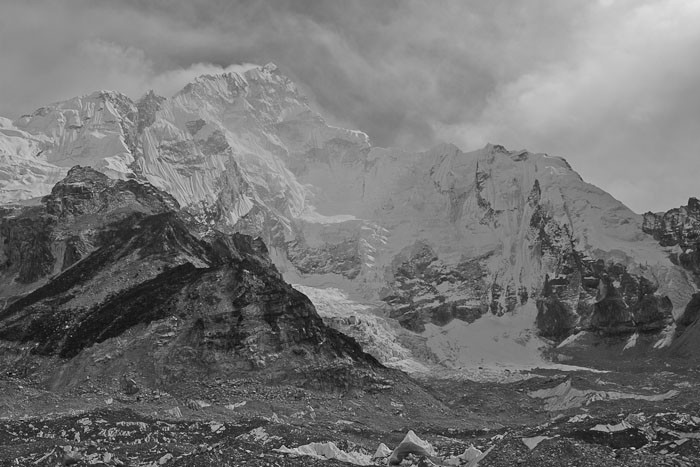
After an hour, we’re in the zone that I’ve come to love, the simple bliss of one foot in front of another, the drumbeat of step-step-stick, thinking about nothing.
I say something to Zac. “Don’t,” he says. “I’m walking. Now you’ve broken my rhythm.”
The cloud muffles all sound, the ice glistens, and up here, I can see what drives people to climb mountains. Not Everest, with its long queues of climbers making its way up the ropes dragged by Sherpas, but the quieter peaks, where you can be alone in the mountains and the silence, snow and cloud enfolding all.
Simultaneously, and schizophrenically, I’m looking forward to the comforts of civilisation, best expressed as a Negroni and a blue steak.
And there it is! The Khumbu icefall, the jumpoff point for Everest.
I stop and snap Zac in front of the spot where more than three thousand souls have started their journey towards the summit, and from which hundreds have never returned.
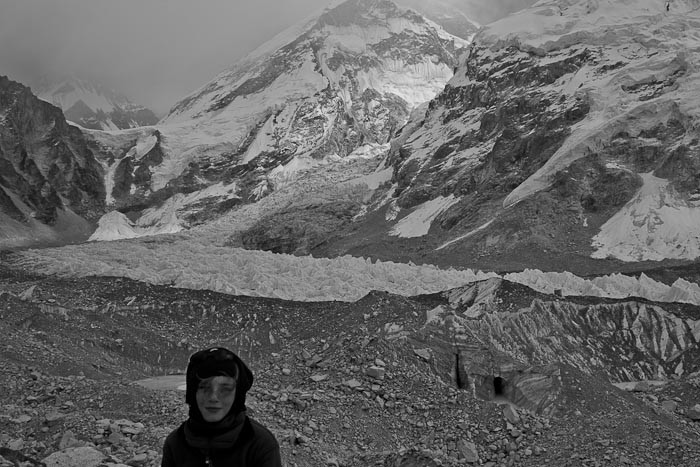
A couple of rubble heaps more, and there’s the sign! The SIGN!
Everest Base Camp is a movable feast, and as most summit attempts are made in May, there is nothing to mark the spot but this plastic banner and some prayer flags, which I strongly suspect to be a few hundred metres ahead of where most people actually place their camps.
There’s a weird rush of disappointment, followed by elation. We’re nowhere, I think. But we’re HERE!
“Wow!” I say to Zac. “I was expecting this to be a total anti-climax, but it isn’t.”
“No,” he says. “I’m surprised too. It feels good to be here.”
“We did it!” I say, and thank Nir profusely.
There’s a little pink sparrow-type bird on top of the rocks lined with prayer flags. I capture him just before he takes flight, frail, vulnerable, warm, soft and so alive in this hard terrain.
He feels, dimly, like a symbol. And as I look at my little boy I feel the same sense of wonder as I did when we finally found our hunter-gatherer in the jungle of the Spice Islands.
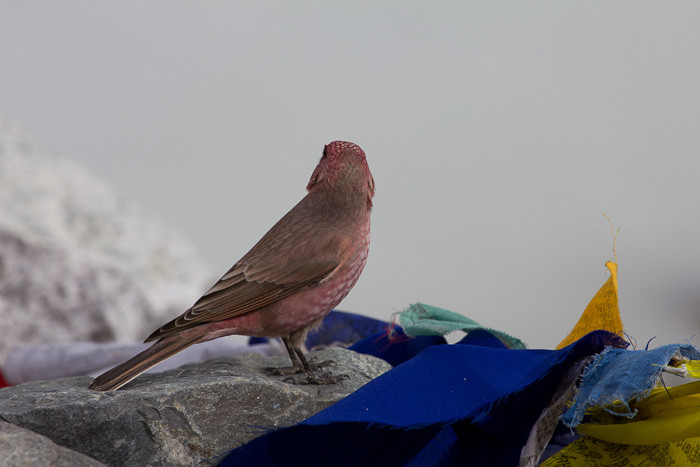
“Mum!” says Zac, inspecting the names marked out in pebbles in the dust, scrawled on rocks in marker pen, decorating the prayer flags. “Do you have a pen?”
Uhoh. I only have a biro. (Doing the Everest Base Camp trek with kids? Bring a marker pen. Moraine is such a mobile landscape that the usual rules about not scrawling your name on natural wonders cease, I feel, to apply.)
“No,” I say. “I’m so sorry! That was so stupid!”
I rummage in my bag. I have a lipstick!
“Use this,” I say, scrawling invisibly on a rock.
“Nah,” Zac says. He has located a computer printout left by some corporate team building expedition, and a piece of cardboard.
Grinning evilly, he squats down and scribbles on his cardboard, then places it over the poor corporate team builders’ expedition memories, weighting it with rocks.
“Oh my god!” I say. “You’ve just turned twelve! And you’ve reached Everest Base Camp on the twelfth of the twelfth, 2012.”
It seems apt, somehow, kind of perfect. It pleases all three of us.
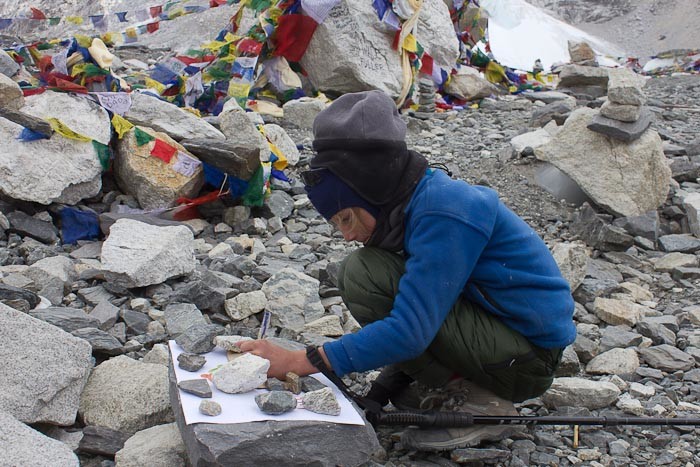
I take some lacklustre photos. By Himalayan standards, the views from Everest Base Camp aren’t all that, but I knew that anyway.
“Time to head back for lunch?” I ask.
The food on the Everest Base Camp trek is by now becoming spectacularly unappealing, but Nir gave us a taste of his “meat” (yak) curry last night, and we’re rather looking forward to having that for lunch.
“Yeah,” says Zac.
My hands are too cold to mess around with the self-timer, so Nir grabs the sign shot.
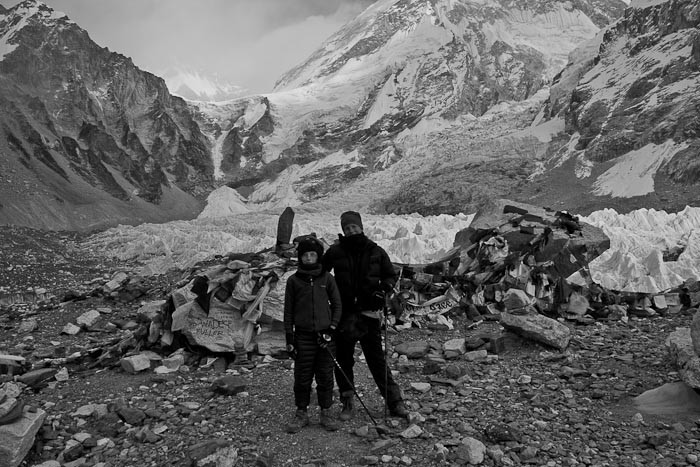
Wow, I think, as we amble gently back across the moraine.
Just Kala Patthar to go, and then we’ve done the whole shebang. And, it looks like the weather might clear soon, so we could nail it this afternoon. We’re well acclimatised, so I don’t see it being difficult.
And it slowly begins to dawn on me that, of course, we have not done the whole shebang. We need – d’oh! — to get back down.
You can read the last post in this series on our Everest Base Camp trek here, start from the beginning here or read about Kala Patthar.
If you’re thinking of doing the Everest Base Camp trek, I recommend my Everest Base Camp FAQs.

amazing! i LOVE the bird, and zac making his own sign.
Thank you! He was so, so beautiful. He really made the moment, if you like.
Nice photos specially of finch…
Ah! He’s a finch, is he? Thank you!
Wow, well done you too. I really enjoyed reading your chronicles. Will be doing the trek in March and can’t wait!
Thank you! You are going by Gokyo Ri, aren’t you? And doing it with a guide or a porter, or even solo, rather than on a group tour? It’s so much more fun to be able to go at your own pace, and it also means that if you’re slow acclimatising you can take extra rest days.
What an amazing experience for both of you but especially for Zac to get to Everest Base Camp at 12! Perhaps he’s not concerned about the bragging rights now but one day he’s going to realize that he has the best stories to tell! That photo of the bird with the prayer flags is beautiful.
Thank you, Lisa. I wish he’d been looking the right way. I got one of him taking off but his wings weren’t quite right.
Well done for making it (and clearly making it down again!), both of you. I can’t imagine a time when my kids will ever be able to walk up to Base Camp. We’re struggling to walk the 500m back up the road at the end of a day of skiing at the moment.
How cold was it at night if you were sleeping in that many layers in -30 sleeping bags?
I have no idea what the actual temperature was. They were fake, so probably in reality only -20 rated, and altitude means your body doesn’t cope so well with cold as it does at sea level, or close to. I’d guesstimate below -20, but not that far below. And, you’d be amazed what your kids will cope with…
Congratulations for reaching the final destination on this Everest trip! I admire your and your son’s courage.
Thank you! Apart from the Cho-La, it was less scarily hard than we’d anticipated.
Wow, what an accomplishment! And for the two of you two have shared that experience together – priceless. If I ever make it there, I’ll be sure to look for Zac’s sign.
Thank you! I SO wish we had a marker pen. Or even nail polish…
You know, Theodora, I’ve been following this series of yours with interest, thinking “If she can do it, I can too”. Now I’m glad you’ve documented everything so well, ’cause I’m happy to have experienced it vicariously through you 🙂
Yes! You CAN do it, too! You really don’t need to be super-fit at all, you just need to take it slowly. And it doesn’t cost nearly as much as everyone thinks, either…
Wow! photographs are lovely and what a tale to tell!!!
The conversational story with some awesome photos make my heart excited.
Thank you, Shubhajit.
Your son is lucky to have you for a mum. The experiences and adventures he’s had before he’s an official teenager are more than most of us have in a lifetime.
Aw, bless you for saying that, Jennifer. Here’s to more adventures in 2013…
Wow, what an amazing experience for him … and you!
It was wonderful, Linda, truly wonderful.
Great post, can’t wait to get there in October! I’ve recommended your site to the charity i’m going with so they can all read about your time there. Whilst i’m sure it’ll be slightly different, the feeling will be the same 🙂
Thanks, Carly! I really do recommend the Gokyo route, or even the Three Passes if you have time — particularly given you’ve done Kili so you’re clearly historically OK with altitude…
Do you create your posts, then save and publish when there are internet connections? I am torn between bringing a device such as an iPad (which I don’t own) or simply brandishing pen and journal to compile entries at a later date. One option is convenient. One option is lightweight and doesn’t need to be charged up, but may lose something in the translation. Decisions, decisions. . .
By the way, I will also look for Zac’s sign! 🙂
Do! I’d imagine it’s been obliterated by now, but if it’s still there, I’d love a picture.
That was pretty much what I did, but I got way behind, because there wasn’t always electricity enough to charge a device, let alone internet. If I weren’t a blogger with a “duty” to post fairly regularly, I would go with journal and paper, which is a lot more atmospheric, and what most people other than me were doing.
I am fully agree with Zac’s article, it is very informative.Thank you for great post and keep it up ahead. One thing i am agree with him that with company or with privet guide you will not have flexible to take extra acclimatization day in any place is not true.As guide i have been this trek many time and we always give our client choice,our client comfort and safety….many more.thank you for good article again.
I meant that with budget group tours you don’t have the flexibility to take the acclimatisation day — of course with a private guide (we went with a porter-guide) you have flexibility.